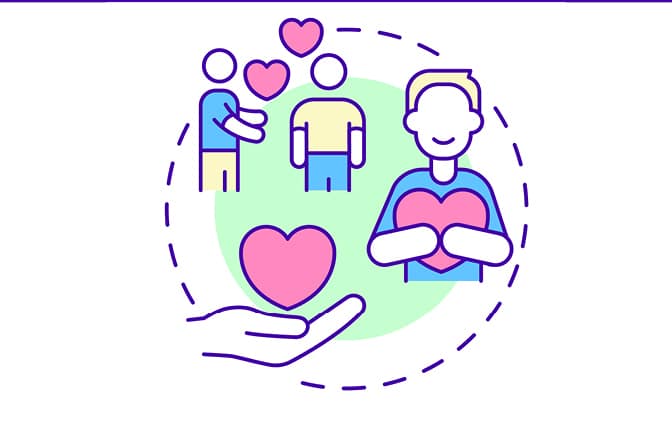
Empathy and Wonder – Helping Students with ADHD
July 18, 2022
ADHD Students and the Responsive Torah Classroom
July 18, 2022by Rabbi Avichai Pepper
It happens in every classroom from coast to coast and abroad. There is that student who seems to struggle with following instructions and staying on task. He may be inattentive to learning, perhaps acting up or displaying hyperactive tendencies, or even impulsiveness. To the eye of most teachers, these characteristics would be consistent with a child that should receive a diagnosis of attention deficit hyperactivity disorder (ADHD.) This child may seem to have similar challenges in any classroom, both with teachers that are more structured or teachers that are more interactive.
In truth, this child may not have ADHD at all. Educators can see the symptoms displayed in the classroom, cafeteria, playground, and interpersonal interactions. What cannot be seen is the cause of these symptoms. When taking a closer look at the reason behind the seemingly hyperactive or inattentive student, an interesting phenomenon may come to light. There are many reasons that a child could display these or other similar symptoms. There is an overlap of symptomatic behavior between children with ADHD and those who suffer from Child Traumatic Stress and Post-Traumatic Stress Disorder (PTSD.)
This is not to suggest that these are the only two possible reasons for what presents in the classrooms as ADHD; there are others, including too much screen time and overstimulation of the brain, as well as other learning disabilities, like auditory processing disorder, that can look like ADHD. In our schools and classrooms, there are children who need mental health interventions. This includes neuropsychological evaluations for ADHD, and screening for child traumatic stress and its impact on children. It is not, nor should it be, the role of a teacher or rebbi to identify or even suggest a diagnosis of ADHD or PTSD. Such concerns should be brought up to the school’s mental health professional or administration as per each school’s protocol. At the same time, each can be dealt with in the classroom setting with some planning.
Symptoms of trauma
Several recently published studies suggest that when looking at the symptoms of ADHD and trauma there is a large overlap (Ferrer, M. 2020). These overlapping symptoms include difficulty concentrating and learning, being easily distracted, disorganization of belongings, supplies, and thoughts, hyperactivity, impulsivity, restlessness, and even sleep challenges. The differences may be harder to identify in a classroom setting.
A child suffering from trauma may also display feelings of fear or helplessness, increased aggressive behaviors, avoidance, and irritability. By contrast, a child with ADHD may display difficulty sustaining attention, challenges following multi-step instructions, fidgeting, or squirming, difficulty waiting for his or her turn, interrupting others, and excessive talking. Because it is not common practice to inquire about possible past traumatic events when evaluating a child for ADHD, the trauma aspect is often overlooked (Siegfried, C.B. & Blackshear, K.L. 2016).
In general, trauma is an event that has an endpoint. Following a trauma, one should take time to process the event and the feelings associated with it. Covid-19, in contrast, has been categorized as an ongoing trauma. This means that there are higher levels of stress due to the lack of certainty and the constant presence of loss and grief (due to loss of loved ones or possible unemployment). Since the onset of Covid-19, more and more children have displayed behaviors that are in line with what presents as ADHD. It is possible, based on this research, that some of the children struggling in our classrooms today may not have ADHD, but rather have been affected by trauma.
In addition to the trauma aspect of the pandemic and our student’s inattention, there is a further intriguing symptomatic overlap to ADHD behaviors. This overlap of symptoms can be found in overuse of social media and overexposure to screen time. Studies have drawn a connection between frequent use of digital media and a reduction of attention spans in children. Children and adolescents that spend extended time viewing a screened device are not only likely to display ADHD behaviors for the next few days but may even develop permanent ADHD symptomatic behavior over time (Ra, C.K., Cho, J., Stone, M.D., De La Cerda, J., Goldenson, N.I. Moroney, E., Tung, I., Lee, S.S., & Leventhal, A.M., 2018).
Screens
Screened devices have an unmeasured power over the development of the brain. In June of 2020, the Food and Drug Administration (FDA) approved the marketing of the first-ever game-based digital therapeutic device used for the improvement of attention functionality of children with ADHD (Food and Drug Administration, 2020). This game is available by prescription only and is designed to train the brain to control impulsiveness and hyperactivity. One can only imagine that if digital media can be designed to counteract ADHD behaviors and help with cognition and the ability to focus, the opposite effect is true of non-RX screen usage. Children with access to screens and an abundance of screen time (specific to social media and gaming), can cause real damage to their brains, perhaps leading to ADHD behaviors.
Accommodations
A child with an ADHD diagnosis should have accommodations made for them. It is always helpful to remember that each student may learn in his or her own manner and style. For some children sitting in a seat might create a much-needed structure, while for another student sitting in a seat may seem like a punishment reserved only for the worst imaginable classroom behavior. Setting up a classroom which can strike a balance, with space for both the student who needs to sit and, out of the way, a standing space for the student who needs to stand, can create a learning space for both. The classroom needs to belong to the learning and the teacher or Rebbi is the manager, conductor, and orator.
A child struggling with grief, stress, and trauma may need therapy. There are a number of institutions that can help a school find the appropriate professional depending on where the school is located. The teachers should be made aware that the child is receiving help, but not necessarily all the rest of the details, keeping to the parent-teacher partnership. In the classroom, this child needs to see and experience patience, care, and love, as do all our students. Creating a place where the child feels safe is the first step in the child’s ability to return to learning. Without leaving the child feeling singled out, curb expectations and give the child something to feel proud of.
It is the responsibility of the school, the teacher, and the rebbi, to create a space that allows the emotional excitement of learning to grow within each talmid. Every child has a desire and thirst for knowledge, to grow and feel good from their learning. However, there are some students who have challenges in the school and classroom setting, and there are various causes that can lead to the same symptoms. Understanding the challenges that face each talmid should be looked upon as an opportunity to draw these desires out and into the success of the child’s learning and the teacher’s teaching.
References
Ferrer, M. (2020). ADHD, PTSD, or Both. https://mydigitalpublication.com/publication/?i=661548&article_id=3681775&view=articleBrowser
Food and Drug Administration, (2020). FDA Permits Marketing of First Game-Based Digital Therapeutic to Improve Attention Function in Children with ADHD. https://www.fda.gov/news-events/press-announcements/fda-permits-marketing-first-game-based-digital-therapeutic-improve-attention-function-children-adhd
Ra, C.K., Cho, J., Stone, M.D., (2018). Association of Digital Media Use With Subsequent Symptoms of Attention-Deficit/Hyperactivity Disorder Among Adolescents. American Medical Association
Siegfried, C.B. & Blackshear, K.L. (2016). Is It ADHD or Child Traumatic Stress? The National Child Traumatic Stress Network
Rabbi Avichai Pepper is a graduate of the New England Rabbinical College in Providence, RI. He holds a Master’s degree in Educational Leadership from Bellevue University, and Master’s degree in Counseling from Liberty University. He is currently a Doctoral candidate at Liberty University’s School of Education. Rabbi Pepper serves as the Director of Student Programming in the Berman Hebrew Academy Lower School and is the Guidance Counselor for Yeshiva of the Greater Washington boys division. He has been involved in chinuch for more than 20 years and is focused on student development and growth in a positive school culture and atmosphere. Contact Rabbi Pepper at [email protected].

